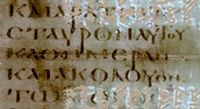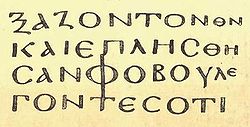Codex Nitriensis
| New Testament manuscript | |
 Fragment with text of Luke 9:23 | |
| Name | Nitriensis |
|---|---|
| Sign | R |
| Text | Gospel of Luke † |
| Date | c. 550 |
| Script | Greek |
| Found | 1842 |
| Now at | British Library, Add MS 17211 |
| Size | 29.5 cm by 23.5 cm |
| Type | Byzantine |
| Category | V |
Codex Nitriensis, designated by R or 027 (in the Gregory-Aland numbering), ε 22 (von Soden), is a 6th-century Greek New Testament codex containing the Gospel of Luke, in a fragmentary condition. It is a two column manuscript in majuscules (capital letters), measuring 29.5 cm by 23.5 cm.[1]
Description
[edit]The text is written in two columns per page, 25 lines per page, in large uncial letters.[2] It has no breathings and accents. The letters are similar to those of codices 081, 022, and 024, only that they are somewhat irregular and straggling.[2]
It is a palimpsest. The upper text contains the Syriac treatise Severus of Antioch against Johannes Grammaticus written in the 8th or 9th century. The lower text of the same manuscript contains the Iliad and the Gospel of Luke, both of the sixth century, and the Euclid's Elements of the seventh or eighth century.[2]
The manuscript contains the tables of the κεφαλαια (tables of contents) before each Gospel, the Pseudo-Ammonian Sections,[3] but no references to the Eusebian Canons.[2]
Contents
[edit]
Gospel of Luke 1:1-13, 1:69-2:4, 2:16-27, 4:38-5:5, 5:25-6:8, 6:18-36, 6:39, 6:49-7:22, 7:44, 7:46, 7:47, 7:50, 8:1-3, 8:5-15, 8:25-9:1, 9:12-43, 10:3-16, 11:5-27, 12:4-15, 12:40-52, 13:26-14:1, 14:12-15:1, 15:13-16:16, 17:21-18:10, 18:22-20:20, 20:33-47, 21:12-22:6, 22:8-15, 22:42-56, 22:71-23:11, 23:38-51.[2]
Text of the codex
[edit]The Greek text of the codex is a representative of the Byzantine text-type in a very early stage, with a large portion of non-Byzantine readings. Aland gave for it the following textual profile - 111 41/2 02 5s. Aland placed it in Category V.[1] According to the Claremont Profile Method it belongs to the textual family Kx in Luke 1 and Luke 10; in Luke 20 it has mixed text.[4]
In Luke 6:2 — οὐκ ἔξεστιν (not lawful) for οὐκ ἔξεστιν ποιεῖν (not lawful to do); the reading is supported only by 𝔓4, Codex Vaticanus, (Codex Bezae), 700, lat, copsa, copbo, arm, geo;[5]
It lacks the text of Luke 22:43-44.[6]

History
[edit]Formerly it belonged to the monastery of St. Mary Deipara in the Nitrian Desert. In 1847 along with the other 550 manuscripts (e.g. British Library, Add MS 14448) it was brought to England by Henry Tattam.[2]
The fragments of Luke were independently transcribed, both by Tregelles in 1854, and by Tischendorf in 1855, who afterwards re-examined the places wherein he differed from Tregelles (e.g. Luke 8:5; 18:1.10).[7] Tischendorf edited the text of the codex in 1857 in his Monumenta sacra inedita, volume VII, with a facsimile.[8]
The 48 extant parchment leaves of the manuscript are kept in the British Library (Add MS 17211) in London.[1][9]
See also
[edit]References
[edit]- ^ a b c Aland, Kurt; Aland, Barbara (1995). The Text of the New Testament: An Introduction to the Critical Editions and to the Theory and Practice of Modern Textual Criticism. Erroll F. Rhodes (trans.). Grand Rapids: William B. Eerdmans Publishing Company. p. 113. ISBN 978-0-8028-4098-1.
- ^ a b c d e f Gregory, Caspar René (1900). Textkritik des Neuen Testaments. Vol. 1. Leipzig: J.C. Hinrichs’sche Buchhandlung. p. 64.
- ^ Rudolph, Ulrich (1989). „Ammonius“ (Pseudo-Ammonius). In: Goulet, Richard. Dictionnaire des philosophes antiques. Paris, 170-171.
- ^ F. Wisse, The profile method for the classification and evaluation of manuscript evidence, as Applied to the Continuous Greek Text of the Gospel of Luke, William B. Eerdmans Publishing, 1982, p. 52.
- ^ NA26, p. 170.
- ^ NA26, p. 232.
- ^ Scrivener, Frederick Henry Ambrose; Edward Miller (1894). A Plain Introduction to the Criticism of the New Testament. Vol. 1 (4 ed.). London: George Bell & Sons. p. 145.
- ^ Bruce M. Metzger, Bart D. Ehrman, The Text of the New Testament: Its Transmission, Corruption and Restoration, Oxford University Press, 2005, pp. 79-80
- ^ "Liste Handschriften". Münster: Institute for New Testament Textual Research. Retrieved 16 March 2013.
Further reading
[edit]- Cureton, William (1851). Fragments of the Iliad of Homer from a Syriac palimpsest. London: The Trustees of the British Museum. p. 1.
- S. P. Tregelles, An Introduction to the Critical study and Knowledge of the Holy Scriptures, London 1856, pp. 183–184.
- C. v. Tischendorf, "Monumenta sarca inedita" II (Leipzig, 1857), pp. XIV-XXII, 1-92.
- Heiberg, J. L., Ein palimpsest der Elemente Euklids, in: Philologus 45 vol., 1885, pp. 353–366.
- Wright, William (1871). Catalogue of the Syriac manuscripts in the British Museum. Vol. 2. London: British Museum. pp. 548–550.
External links
[edit]- Codex Nitriensis R (027) at the Encyclopedia of Textual Criticism
- Add MS 17211 Archived 2015-12-28 at the Wayback Machine at the British Library


 French
French Deutsch
Deutsch